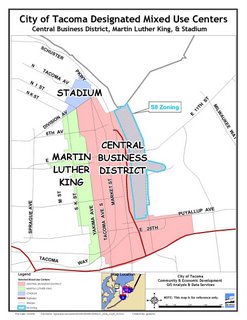 Earlier today, this quarter's City Center Luncheon focused on downtown housing with the exploration of perspectives from both public and private sector leaders.
Earlier today, this quarter's City Center Luncheon focused on downtown housing with the exploration of perspectives from both public and private sector leaders.Ryan Petty, director for the City of Tacoma's Community & Economic Development Department, began the process by recapping a presentation he made to the Tacoma City Council on August 22nd. The presentation reviewed the current status of housing in Tacoma's urban center and laid out a variety of potential policy options.
As currently defined, Petty stated, downtown has about 1,260 residences; approximately 47% are classified as low income. To date, there are an additional 1,400 units under construction or permitted with 300 more units approved by the City Council under the Property Tax Exemption Program; of these new units, 137 are for low-income seniors, 60 for special needs families, and all the others are market rate.
Petty related goals for housing already adopted by the City of Tacoma:
- Maintain and support vibrant and stable residential neighborhoods
- Promote a variety of housing opportunities for Tacoma’s citizens at all income levels
- Support the development of both market rate and affordable housing throughout the city
- Insure that any new affordable housing development is not concentrated in any single neighborhood or group of neighborhoods
He then presented two goals that support those above while also recognizing the current concentration of low income residences in downtown:
- Support and encourage mixed income housing development
- Reduce the isolation of low and very low income households
Another proposal from Petty and his CEDD staff (originally offered by City Manager Eric Anderson) is to establish mixed income ratio by project and/or by area or vicinity. A typical ratio for such a policy is 80%/20%, where 80% of the units are market rate and 20% of the units are “affordable” (i.e., low income).
In summary, Petty's presentation indicated that members of the City Council are considering the following policy changes:
- Require Council approval of any housing development project in the downtown before it can be considered for funding
- Establish a dollar limit beyond which Council makes funding decisions
- Establish boundaries for a new “large footprint” downtown
- Adopt guidelines to encourage mixed income development
- Support the above with incentives
Participants in the luncheon also heard from a panel of private sector representatives; their input here on Monday.


Can we find out what the Downtown population would be with the new Downtown area proposal?
ReplyDeleteI am always hearing the concerns about a downtown grocery store...I have also heard that the really big condo development occuring near the triangle homes developement is slated to have a grocery in the ground floor. Does anyone know if this is true?
ReplyDeleteIf not: here's a thought. There already is a grocery store...I saw a sign near the marina saying there was a grocery store there.
I don't know how big it is, and I'm sure it's pretty small now,but perhaps we can give the owner some help from the city to expand and if it was advertised people would start coming down for necessity items like bread and milk....helping the store to grow and become a resource for the whole downtown rather than just the marina. It would be good for the owner, the marina and the downtown.
Just an idea.
jules@urbanX